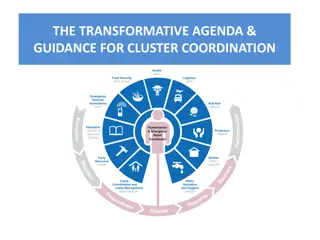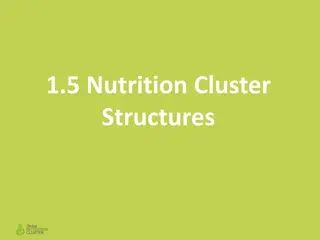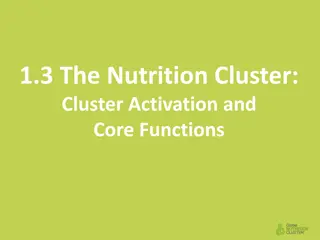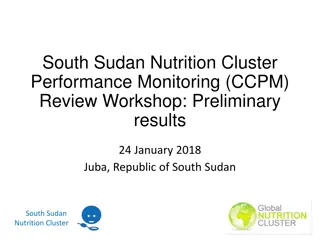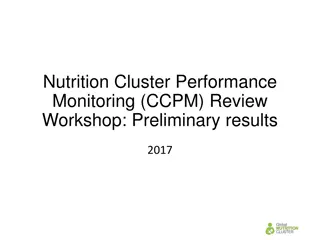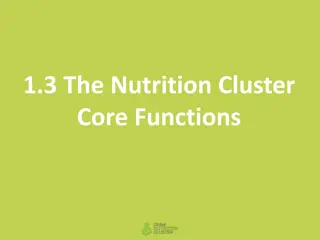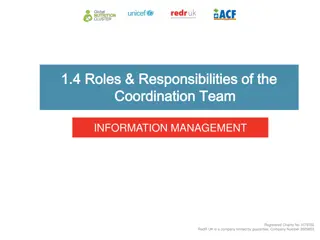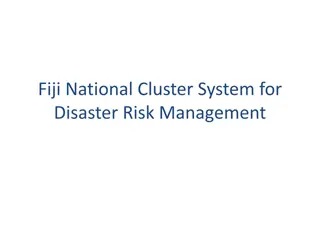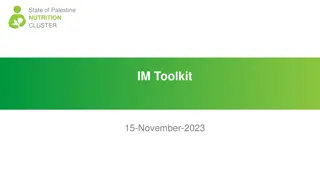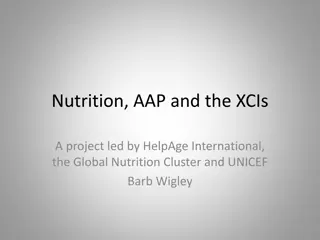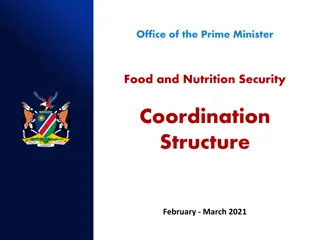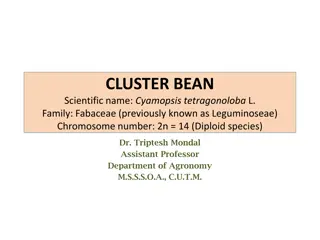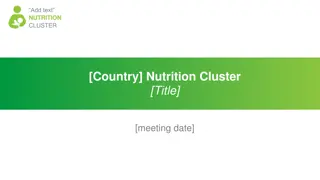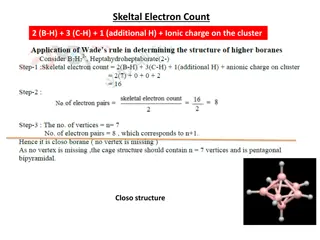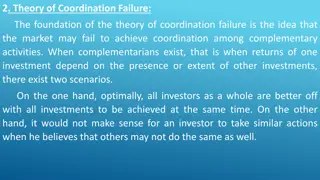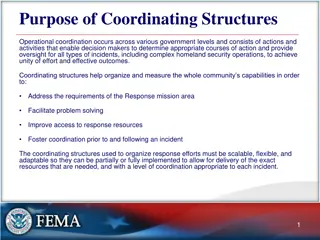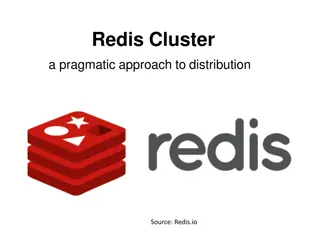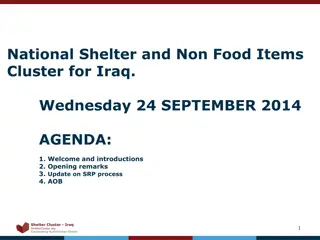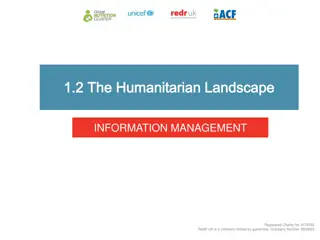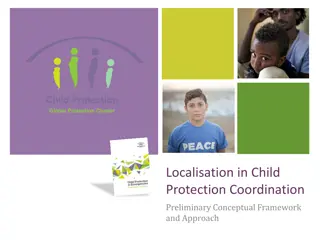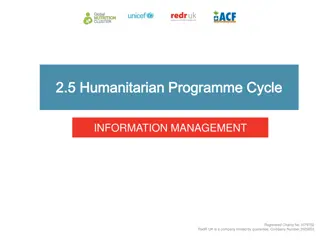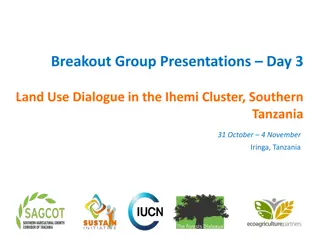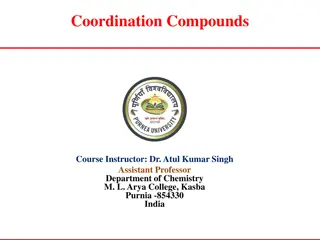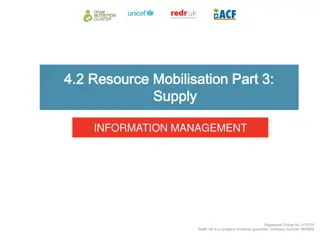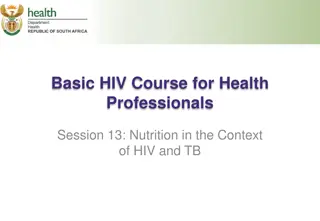Understanding Nutrition Cluster Structures and Coordination Roles
Explore the diverse structures and roles of actors within nutrition clusters at various levels, from global to sub-national. Learn about the responsibilities of key players such as Cluster Coordinators, Information Managers, and Technical Working Groups. Discover the government's role in the nutrition sector and the importance of sub-national coordination for effective humanitarian response.
Download Presentation

Please find below an Image/Link to download the presentation.
The content on the website is provided AS IS for your information and personal use only. It may not be sold, licensed, or shared on other websites without obtaining consent from the author. Download presentation by click this link. If you encounter any issues during the download, it is possible that the publisher has removed the file from their server.
E N D
Presentation Transcript
1.4 Nutrition Cluster Structures
Objectives of this Session By the end of this session, participants will be able to: Identify the different structures and roles actors at different levels (global, country, sub-national, etc.) Identify the different structures and roles of the Nutrition Cluster and other actors at different levels (global, country, sub-national, etc.) Outline the responsibilities of the Cluster Coordinator and the Information Manager and the Strategic Advisory Group (SAG) and Technical Working Groups (TWiGs).
Actors in Humanitarian Response National Government OCHA Humanitarian Response Cluster Lead Agency UN Agencies Nutrition Cluster (national and sub-national) Global Nutrition Cluster CS/C NGOs Observers
Government Role in the Nutrition Cluster/Sector? Co-lead/co-chair of the NC Or One of the NC s primary partners How is it in your country?
Nutrition Cluster/Sector Structure at National Level Nutrition Cluster or Sector Nutrition Cluster/Sector Coordination Team TwiGs SAG TwiGs TwiGs = NC Partners
SAG & TWiG Strategic Advisory Groups (SAG) Technical Working Groups (TWiG) Consists of key operational partners Members nominated and elected Develops and adjusts Cluster s strategic framework, priorities and work plan. Membership represents overall Cluster partnership Enables decision-making on behalf of the larger group through representation of stakeholder groups. Is expected to interact with its broader Cluster membership to ensure a regular flow of information Are created as needed, for example to agree on minimum standards and formulate appropriate technical practices. Small, task-oriented and time-limited groups Coordinated by a focal point or technical adviser, and composed of relevant technical experts Self-selected membership TWiGs advise the SAG
Sub-national Coordination Cluster/Sector decentralized in zones of special importance: For example, decentralization can be necessary: If responses take place in remote areas (e.g. South Sudan) If response area is very large (e.g. DRC) If decision making needs to be decentralised (e.g. Nigeria) Sometimes the cluster can be merged, i.e. Health and Nutrition Cluster, together on sub-national level
Sub-national Coordination Specific focal points identified to lead the sub-national clusters, with a clear individual ToR/scope of work ToRs developed to guide the governance and deliverables of the nutrition sub-cluster Clear communication lines, reporting systems and support mechanisms established between national and sub-national clusters. Inputs and processes of sub-national clusters should fit into the broader, national, coordination strategy Sub-national clusters may not mirror all the functions of the national cluster - prioritisation of tasks needs to be discussed with operational partners and the national cluster
Nutrition Cluster/Sector Structure at Sub-national Level Sub-national Nutrition Cluster or Sector Sub-National Nutrition Cluster/Sector Coordination Team Operational TWGs? (e.g . Supply management, nutrition information etc...) = NC Partners
Cluster/Sector Team at Sub-national Level The Cluster/Sector Coordination team at sub-national level provides a forum around which all Cluster/Sector partners can discuss and coordinate their operations Sub-national clusters usually include: Sub-national Cluster/Sector Coordinator (in some contexts a government focal point) Sub-national Information Manager Translator (if necessary) Local authorities (administrative and technical) UN agencies and NGOs implementing nutrition in emergencies activities 10
Sub-national Nutrition Cluster in XXX Led by Co-lead- Partners:
Group Work: Role of the NCC and the SNCC In pairs, discuss the role of the Nutrition Cluster Coordinator at national and sub- national level
NCC Responsibilities (national) Establishing andmanaging coordination Facilitating needs assessments Identification and addressing of gaps and duplications Ensuring information flow Supporting application of standards Advocacy Mobilization of resources (incl. funds) Facilitation of development of Cluster Humanitarian Response Plan Ensures monitoring NC performance Coordination Promoting quality and accountability And much more
NCC Responsibilities (subnational) Establishing andmanaging coordination at sub-national level Facilitating needs assessments on the ground Identification and addressing of gaps and duplications Ensuring information flow Supporting application of standards Advocacy to the national level Facilitation of development of Sub-national work plan Ensures monitoring NC performance Coordination Promoting quality and accountability And much more
Relationships between National and Sub-national Level UNICEF RO and HQ Humanitarian Coordinator UNICEF Country Rep Government at national level National NCC National level Sub-national Nutrition Cluster Coordinator Supervisor/chief of Field Office Government at sub-national level Sub-national Information Manager Nutrition Cluster Partners (including UNICEF as a Cluster partner) Sub-national level
Organisational Accountability What organisations are formally responsible for Is the key for an effective and efficient cluster! Formal Accountability Mutual Accountability Shared aims and collective outcomes Humanitarian actors NOT accountable to cluster leads Shared decision making Non-UN actors NOT accountable to UN agencies Open, transparent dialogue Getting the best possible results for affected people Joint responsibility Only held accountable for specific commitments Interest in regularly improving functions and coordination
Not just the Cluster Coordinators job! All cluster partners (including CLAs in their role as implementer alongside other agencies) have a shared mutual responsibility to meet the humanitarian needs of affected people in a timely, effective and appropriate manner. 17
Key Messages: The NCC has clearly defined responsibilities, as do other parts of the system All actors have specific roles that contribute to an effective and coordinated nutritional response. Keeping the focus on mutual responsibility for better results and accountability to affected people can help overcome organisational barriers towards working collectively. The cluster coordinator cannot assume sole responsibility it is a collective responsibility of all actors



